Powwow, also called Brauche or Braucherei in Deitsch, is a vernacular system of North American traditional medicine and folk magic originating in the culture of the Pennsylvania Dutch. Blending aspects of folk religion with healing charms, "powwowing" includes a wide range of healing rituals used primarily for treating ailments in humans and livestock, as well as securing physical and spiritual protection, and good luck in everyday affairs. Although the word "powwow" is Native American, these ritual traditions are of European origin and were brought to colonial Pennsylvania in the transatlantic migrations of German-speaking people from Central Europe in the Seventeenth and Eighteenth Centuries. A practitioner is sometimes referred to as a "Powwower" or Braucher, but terminology varies by region. The folk traditions continues in the present day in both rural and urban settings, and has spread across North America.
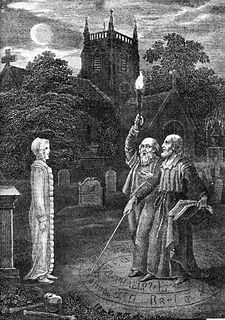
Black magic has traditionally referred to the use of supernatural powers or magic for evil and selfish purposes. With respect to the left-hand path and right-hand path dichotomy, black magic is the malicious, left-hand counterpart of the benevolent white magic. In modern times, some find that the definition of "black magic" has been convoluted by people who define magic or ritualistic practices that they disapprove of as "black magic".

In European folklore and folk-belief of the Medieval and Early Modern periods, familiar spirits were believed to be supernatural entities that would assist witches and cunning folk in their practice of magic. According to the records of the time, they would appear in numerous guises, often as an animal, but also at times as a human or humanoid figure, and were described as "clearly defined, three-dimensional… forms, vivid with colour and animated with movement and sound" by those alleging to have come into contact with them, unlike later descriptions of ghosts with their "smoky, undefined form[s]".
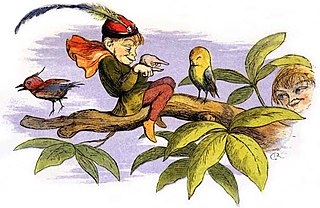
English folklore is the folk tradition which has developed in England over a number of centuries. Some stories can be traced back to their roots, while the origin of others is uncertain or disputed. England abounds with folklore, in all forms, from such obvious manifestations as the traditional Robin Hood tales, the Brythonic-inspired Arthurian legend, to contemporary urban legends and facets of cryptozoology such as the Beast of Bodmin Moor.

A witch doctor was originally a type of healer who treated ailments believed to be caused by witchcraft. The term witch doctor is sometimes used to refer to healers, particularly in regions which use traditional healing rather than contemporary medicine..
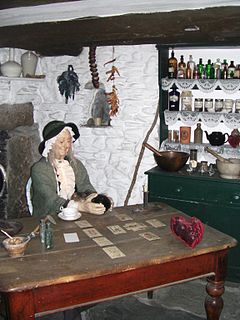
The cunning folk in Britain were professional or semi-professional practitioners of magic in Britain, active from the Medieval period through the early twentieth century. As cunning folk, they practised folk magic – also known as "low magic" – although often combined with elements of "high" or ceremonial magic, which they learned through the study of grimoires. Primarily using spells and charms as a part of their profession, they were most commonly employed to use their magic in order to combat malevolent witchcraft, to locate criminals, missing persons or stolen property, for fortune telling, for healing, for treasure hunting and to influence people to fall in love. Belonging "to the world of popular belief and custom", the cunning folk's magic has been defined as being "concerned not with the mysteries of the universe and the empowerment of the magus [as ceremonial magic usually is], so much as with practical remedies for specific problems." However, other historians have noted that in some cases, there was apparently an "experimental or 'spiritual' dimension" to their magical practices, something which was possibly shamanic in nature.
Evocation is the act of calling upon or summoning a spirit, demon, god or other supernatural agent, in the Western mystery tradition. Comparable practices exist in many religions and magical traditions and may employ the use of mind-altering substances with and without uttered word formulas.
Obeah is a system of spiritual and healing practices developed among enslaved West Africans in the West Indies. Obeah is difficult to define, as it is not a single, unified set of practices; the word "Obeah" was historically not often used to describe one's own practices. Some scholars, such as Diana Paton, have contended that what constitutes Obeah in Jamaica has been constructed by white society, particularly law enforcement. Accordingly, different Afro-Caribbean communities use their own terminology to describe the practice, such as "science", among the Jamaican Windward Maroons. Obeah is similar to other Afro-American religions such as Palo, Haitian Vodou, Santería, and Hoodoo in that it includes communication with ancestors and spirits and healing rituals. Nevertheless, it differs from religions like Vodou and Santeria in that there is no explicit canon of gods or deities that is worshipped, and the practice is generally an individual action rather than part of a collective ceremony or offering. It differs from Myal in that Myal focuses more on the connection of humans and spirits. By some early colonial authorities they differed in that Obeah was viewed as nefarious while Myal was a more positive influence.

Snake charming is the practice of appearing to hypnotize a snake by playing and waving around an instrument called a pungi. A typical performance may also include handling the snakes or performing other seemingly dangerous acts, as well as other street performance staples, like juggling and sleight of hand. The practice is most common in India, though other Asian nations such as Pakistan, Bangladesh, Sri Lanka, Thailand, and Malaysia are also home to performers, as are the North African countries of Egypt, Morocco and Tunisia.

A folk healer is an unlicensed person who practices the art of healing using traditional practices, herbal remedies and even the power of suggestion. A folk healer may be a highly trained person who pursues their specialties, learning by study, observation and imitation. In some cultures a healer might be considered to be a person who has inherited the "gift" of healing from his or her parent. The ability to set bones or the power to stop bleeding may be thought of as hereditary powers.

Belief in and practice of witchcraft in Europe can be traced to classical antiquity and has continuous history during the Middle Ages, culminating in the Early Modern witch hunts and giving rise to the fairy tale and popular culture "witch" stock character of modern times, as well as to the concept of the "modern witch" in Wicca and related movements of contemporary witchcraft.

The study of magic in the Greco-Roman world is a branch of the disciplines of classics, ancient history and religious studies. In classical antiquity, including the Hellenistic world of ancient Greece and ancient Rome, historians and archaeologists view the public and private rituals associated with religion as part of everyday life. Examples of this phenomenon are found in the various state and cult temples, Jewish synagogues and churches. These were important hubs for ancient peoples, representing a connection between the heavenly realms and the earthly planes. This context of magic has become an academic study, especially in the last twenty years.

White magic has traditionally referred to the use of supernatural powers or magic for selfless purposes. Practitioners of white magic have been given titles such as; wise men or women, healers, white witches or wizards. Many of these people claimed to have the ability to do such things because of knowledge or power that was passed on to them through hereditary lines, or by some event later in their lives. White magic was practiced through: healing, blessing, charms, incantations, prayers, and songs.. With respect to the philosophy of left-hand path and right-hand path, white magic is the benevolent counterpart of malicious black magic. The eternal dualism of night and day may compromise the totality of it's sphere of action. Because of its ties to traditional Paganism, white magic is often also referred to as "natural magic".
Stregoneria is the modern word in Italian that is commonly translated into English as the word witchcraft. In the Italian dictionary—Vocabolario della Lingua —stregoneria is defined as a magical practice intended to produce harm or illness. The statement that stregoneria refers to a harmful magical practice is supported by ethnologist Elsa Guggino, who states that words related to stregoneria are always used disparagingly to describe someone practicing malevolent magic. This is also noted by scholar Gary R. Varner, in his book Charles G. Leland: The Man & the Myth, in which he states that the word strega (witch) is a disparaging term used to denote those who practice black magic, and that the term "maga" is used to denote those who practice white magic and healing.
Magic in Anglo-Saxon England refers to the belief and practice of magic by the Anglo-Saxons between the fifth and eleventh centuries AD in Early Mediaeval England. In this period, magical practices were used for a variety of reasons, but from the available evidence it appears that they were predominantly used for healing ailments and creating amulets, although it is apparent that at times they were also used to curse.
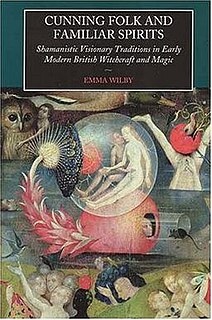
Cunning Folk and Familiar Spirits: Shamanistic Visionary Traditions in Early Modern British Witchcraft and Magic is a study of the beliefs regarding witchcraft and magic in Early Modern Britain written by the British historian Emma Wilby. First published by Sussex Academic Press in 2003, the book presented Wilby's theory that the beliefs regarding familiar spirits found among magical practitioners – both benevolent cunning folk and malevolent witches – reflected evidence for a general folk belief in these beings, which stemmed from a pre-Christian visionary tradition.
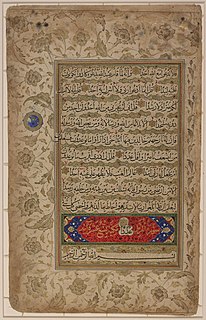
Exorcism in Islam is called ruqya, and is thought to repair damage believed caused by jinn possession, witchcraft (shir) or the evil eye. Exorcisms today are part of a wider body of contemporary Islamic alternative medicine called al-Tibb al-Nabawi.

Little Charmers is a Canadian CGI children's television series produced by Nelvana Enterprises and Spin Master Entertainment for Treehouse TV. The series premiered on Nickelodeon in the United States on January 12th, 2015 and ended in April 15th, 2017. Treehouse TV announced a week later that it was scheduled in Canada on the last day of January; however, episode 2 debuted 6 days after this announcement, and 6 days prior to the scheduled debut.
Gwen ferch Ellis was born around 1542 in Llandyrnog in the Vale of Clwyd. The record of her trial is the earliest record of trial and execution on charges of witchcraft in Wales. She was first accused of Witchcraft in 1594. She was found guilty and hanged before the year's end.















